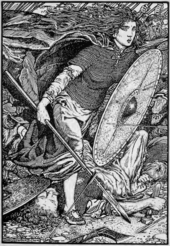
Ragnar Lodbrok, according to legends, was a Viking hero and a Swedish and Danish king.
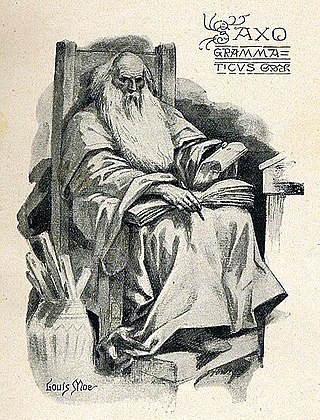
Saxo Grammaticus, also known as Saxo cognomine Longus, was a Danish historian, theologian and author. He is thought to have been a clerk or secretary to Absalon, Archbishop of Lund, the main advisor to Valdemar I of Denmark. He is the author of the Gesta Danorum, the first full history of Denmark, from which the legend of Amleth would come to inspire the story of Hamlet by Shakespeare.
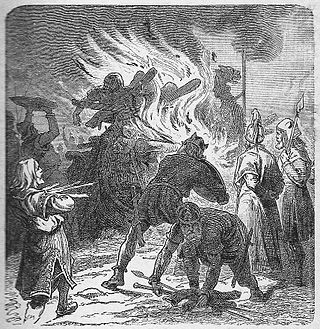
Sigurd Ring according to legend was a king of the Swedes, being mentioned in many old Scandinavian sagas. According to these sources he was granted rulership over Sweden as a vassal king under his uncle Harald Wartooth. Later he would take up arms against his uncle Harald in a bid to overthrow him and take the crown of Denmark, a conflict which Sigurd eventually won after the legendary Battle of the Brávellir, where it is said that Odin himself intervened and killed Harald. In the Sagas, Sigurd is also known for being the father of the Norse Viking hero and legendary king of Denmark and Sweden, Ragnar Lodbrok. According to Bósa saga ok Herrauds, there was once a saga on Sigurd Ring, but this saga is now lost.

Harald Wartooth or Harold Hiltertooth was a semi-legendary king of Denmark who is mentioned in several traditional sources. He is held to have (indirectly) succeeded his father as king of Zealand and to have expanded his realm. According to different sources, he may have ruled over Jutland, part of Sweden and the historical northern German province of Wendland. He is said to have been finally defeated and killed at the legendary Battle of Bråvalla.

Björn Ironside, according to Norse legends, was a Norse Viking chief and Swedish king. According to the 12th- and 13th-century Scandinavian histories, he was the son of notorious Viking king Ragnar Lodbrok and lived in the 9th century, between 855 and 858. Björn Ironside is said to have been the first ruler of the Swedish Munsö dynasty. In the early 18th century, a barrow on the island of Munsö was claimed by antiquarians to be Björn Järnsidas hög or Björn Ironside's barrow.
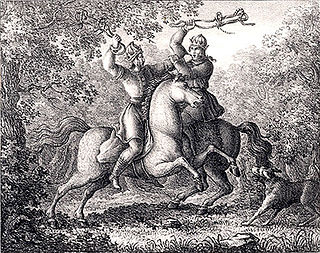
Alaric and Eric, according to legend, were two kings of Sweden.

A shield-maiden was a female warrior from Scandinavian folklore and mythology.
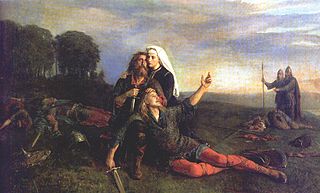
A legendary saga or fornaldarsaga is a Norse saga that, unlike the Icelanders' sagas, takes place before the settlement of Iceland. There are some exceptions, such as Yngvars saga víðförla, which takes place in the 11th century. The sagas were probably all written in Iceland, from about the middle of the 13th century to about 1400, although it is possible that some may be of a later date, such as Hrólfs saga kraka.
Bósa saga ok Herrauds or Saga of Bósi and Herraud is a legendary saga, relating the fantastic adventures of the two companions Herraud and Bósi. It is first attested in three manuscripts from the 15th century, AM 343 a 4to, AM 577 4to, and AM 586 4to.

Sigurd Snake-in-the-eye or Sigurd Áslaugsson was a semi-legendary Viking warrior and Danish king active from the mid to late 9th century. According to multiple saga sources and Scandinavian histories from the 12th century and later, he is one of the sons of the legendary Viking Ragnar Lodbrok and Áslaug. His historical prototype might have been the Danish King Sigfred who ruled briefly in the 870s. Norwegian kings' genealogies of the Middle Ages name him as an ancestor of Harald Fairhair and used his mother's supposed ancestry the Völsung to create an ancestry between Harald and his descendants and Odin.

Halfdan Ragnarsson was a Viking leader and a commander of the Great Heathen Army which invaded the Anglo-Saxon kingdoms of England, starting in 865.

The blood eagle was a method of ritual execution as detailed in late skaldic poetry. According to the two instances mentioned in the Christian sagas, the victims were placed in a prone position, their ribs severed from the spine with a sharp tool, and their lungs pulled through the opening to create a pair of "wings". There has been continuing debate about whether the rite was a literary invention of the original texts, a mistranslation of the texts themselves, or an authentic historical practice.

Harthacnut or Cnut I was a semi-legendary King of Denmark. The old Norse story Ragnarssona þáttr makes Harthacnut son of the semi-mythic viking chieftain Sigurd Snake-in-the-Eye, himself one of the sons of the legendary Ragnar Lodbrok. The saga in turn makes Harthacnut the father of the historical king, Gorm. It has been suggested he is to be identified with the Hardegon of Northmannia whose early-10th century conquest of Denmark was related by Adam of Bremen.

The Battle of Hjǫrungavágr is a semi-legendary naval battle that took place in the late 10th century between the Jarls of Lade and a Danish invasion fleet led by the fabled Jomsvikings. This battle played an important role in the struggle by Haakon Sigurdsson to unite his rule over Norway. Traditionally, the battle has been set during the year 986, though the Gesta Wulinensis ecclesiae pontificum has the year 984 as the year of the battle.
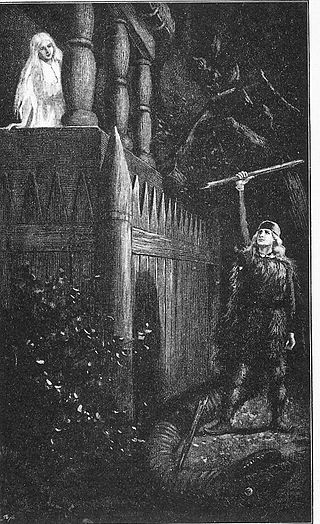
Thora Borgarhjört, is a mythical character in the Norse sagas – the wife of Ragnar Loðbrók, who kills a serpent to win her hand in marriage. Thora was the daughter of Herrauðr, the Earl of Götaland.
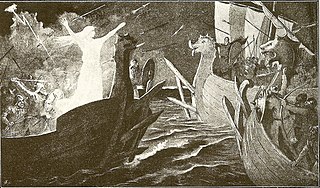
Þorgerðr Hölgabrúðr and Irpa are divine figures in Norse mythology. They appear together in Jómsvíkinga saga, Njáls saga, and Þorleifs þáttr jarlsskálds. Irpa's name does not appear outside of these four attestations, but Þorgerðr also appears in the Prose Edda book Skáldskaparmál, Færeyinga saga, and Harðar saga ok Hólmverja and is mentioned in Ketils saga hœngs.

Vikings is a historical drama television series created and written by Michael Hirst for the History channel, a Canadian network. Filmed in Ireland, it premiered on March 3, 2013, in Canada. The series concluded on December 30, 2020, when the second half of the sixth season was released in its entirety on Amazon Prime Video in Ireland, ahead of its broadcast on History in Canada from January 1 to March 3, 2021. A sequel series, titled Vikings: Valhalla, premiered on Netflix on February 25, 2022.
The Tale of Ragnarr loðbrók is an Icelandic legendary saga of the 13th century about the Viking ruler Ragnarr loðbrók. It is first found in the same manuscript as Vǫlsunga saga, which it immediately follows. The tale covers the origin of Áslaug, Ragnarr's quest for the hand of Þóra borgarhjǫrtr, his later marriage to Áslaug, the deeds of their sons in battle, and Ragnarr's death at the hands of king Ælla of Northumbria.
Rusla, also known as the "Red Woman" from Middle Irish Ingean Ruagh, was a legendary Norwegian shield-maiden mentioned in the Gesta Danorum or "History of the Danes" of Saxo Grammaticus and in the Irish annals. According to Saxo, Rusla was the daughter of a fifth or sixth century king of Telemark called Rieg, and sister of Tesandus (Thrond), who was dispossessed of his throne by a Danish king named Omund. Rusla formed a pirate fleet to attack all Danish ships as revenge for the affront to her brother. Rusla was always accompanied by another woman, Stikla, who was her deputy in all raids. Stikla turned to piracy to avoid marriage, and her name is the origin of the Norwegian city of Stiklestad.

Sigfred was a competitor for the Danish throne in 812. His brief appearance inaugurated a period of throne struggles in Denmark which lasted until 827.
